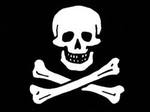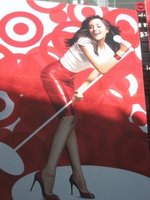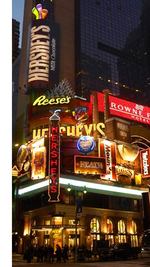Converting the Converted, and Other Tricks of the Light
On Wednesday at the One Show Festival, design guru Brian Collins illustrated the power of branding with a history lesson about pirates.
Or rather, just their flag.
Back in 1748, if you had the misfortune of being a single bobbing ship at sea when a tattered vessel with a skull and crossbones crossed your path, you knew instantly what to expect.
"You're fucked." (Collins, verbatim.)
"As you sail closer," he continued, "the brand promise is reinforced by everything you see."
A cannon fires, shots go off: the brand promise becomes brand immersion. In three hours, maybe less, the brand delivers everything it promised: death, pillage, and maybe a not-so-promising hostage situation.
The fulfillment of the skull-and-crossbones "brand promise" remained so consistent over fifty-plus years that, by the 1800s, pirates didn't even need to waste gunpowder. They had only to raise the black flag to yield the desired results: surrender, animal fear, free doubloons and maybe some teabags.
Pirates (TM!) succeeded because they connected brand promise to performance.
So what is a brand? According to Collins, a brand is a promise made consistently over time. Logic follows that if the "promise" perceived in the advertising is honored by the product or service, the brand flies.
Brands live in three areas: communication, environmental and product design.
Advertisers suffer from an interruptive mindset. Most treat their craft the way they imagine people see it: as that crap between what people really want: their TV shows, their city parks, their magazine article, their gorgeous baseball game.
This is what's considered invasion.
And "invasion" doesn't have to be the way we do business. The challenge posed to advertisers -- often the gatekeepers of a person's very first brand experience -- is to move from "advertising thinking" to "design thinking."
Ad thinking delivers promises with interruptive messaging. Design thinking "delivers performance through empathic experience." In other words, a craftily designed ad is something people want to engage. (And not just in the CLICK HERE! sense.) Sometimes they'll even seek it out.
Consider the Target ads that litter Times Square.
The nearest Target is in Brooklyn. So if Target dares hawk its wares so far from the most accessible point of access, one would hope it isn't setting outlandish expectations.
Brian Collins says Target does a great job of delivering on its ad promises. (It also did a great job of making one of Brian Collins' students, Deborah Adler, a household name in product design. For a school project, Adler designed what is now Target's user-friendly Clear Rx line.)
"Everything that I was promised in the billboard, I get -- from the threshold, to walking in the store, even to the paper towels," Collins gushed. All this represents "continuity of design thinking" from the brand to the destination.
That continuity is what contributes to Target's brand success: its friendly, clean and almost-overbearingly-chic ads are part of what sell the store. And I suppose some would argue Target's store is also friendly, clean and chic. Compared to the alternatives, anyway.
"Brands that can build a connection between what you promise and what you get can have remarkable success because NOBODY does it."
The meet-expectations shtick its one of Collins' mantras, along with respecting your surrounding environment (he HATES the Cottonelle ads that drape Philly's otherwise-majestic Union Station) and turning advertising into ends in themselves, not just means to an end.
Collins' mind is the source of the Hershey's chocolate factory on Times Square -- the one you avoid because your kids will throw an "I-need-Kisses!" tantrum. He is also responsible for Helios House, a BP gas station made of recycled aluminum.
Helios House returns electricity to the community while you pump gas. Better still, it has a spotless bathroom that people allegedly drive five miles out of their way to use on average.
"When design is fantastic, it creates its own media," he said, referring to the mounds of coverage that have surrounded his pet projects: little more than glorified ads that people want to walk into and take pictures of.
We were all moved -- if not by the purity of his conviction, then by the strength of his feelings for Target. When a listener asked why he left Ogilvy to strike out on his own, he attributed it to creative differences between himself -- an "experience" evangelist -- and Cannes junkies obsessed with TV spots.
"If the advertising industry thinks the height of its power is getting a :30 spot on the Super Bowl, then we're doomed," he pronounced.
Another audience member requested an assignment. Without missing a beat, Collins passed out pieces of paper from an oddly convenient pile by the podium. He told us to use it to write a no-holds-barred letter to the person we admire. People began at once.
"Now send it," he concluded dramatically. And to timid chuckles resounding in the audience, he added, "The word 'no' is just a request for more information. Just keep sending them your stuff until they say 'fuck, I gotta talk to you.'"
Very Della Femina.
In the second or two that he stood motionless and observing his flock of the design-converted, I froze mid-sentence in the middle of my scrawled paean to Jesus. It occurred to me that I've never, at any of the seminars I've ever been to, heard anyone ask the speaker for homework.
The longer I think about it, the more convinced I am it was one of Collins' manufactured moments.
Topic: Brands, Creative Commentary, Industry Events, Opinion







Comments
Did Collins or you ever think that millions of people in Manhattan might just shop Target.com and not actually walk into a store. In a city where they deliver your meals, liquor and groceries, why wouldn't you have your furniture or paper towels delivered.
Free shipping for every $50 order. Do you know how easy it is to spend $50 at Target. If you think you are getting out of Target for under $50 - what did Collins say - "You're fucked."
Did Collins or you ever think that millions of people in Manhattan might just shop Target.com and not actually walk into a store. In a city where they deliver your meals, liquor and groceries, why wouldn't you have your furniture or paper towels delivered.
Free shipping for every $50 order. Do you know how easy it is to spend $50 at Target. If you think you are getting out of Target for under $50 - what did Collins say - "You're fucked."
The man's brilliant. Definitely years ahead of the rest of the industry.
Now that this has been put on the web he really needs to say something else. I have seen this guy speak three times and he has repeated the same remarks all three times in the past two or three years. I would like to hear some new thinking, if there is any.
Hello, Jake.
You're damn right.
And that was the LAST time I hauled out that speech. I thought I could use it as it was for students. None of them had heard it before. Still, two college professors right after this event asked if I would give that same talk to their students next year.
C'est la vie.
Look - if you're going to Design Camp in Minnesota or to the AIGA Conference in New York this fall, let me know. I'll get you a ticket if you promise to tell me right afterwards if you hear any new thinking - or if you just think my talk the same story on a different day.
Are your actions as bold as your words?
Let me know.
brian@collins1.com
And, thanks for keeping me on my toes.
Warmest wishes from 5th Avenue,
Brian